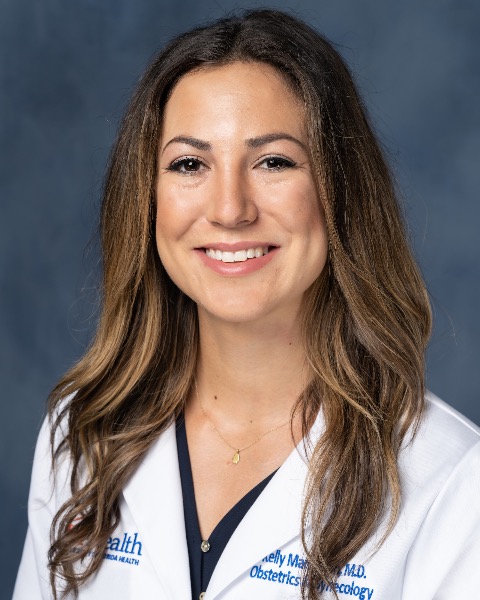Assessment of OBGYN Residents' Knowledge of OASIS: A Pre-Intervention Survey

Kelly Mamelson, MD (she/her/hers)
Resident Physician
University of Florida College of Medicine
Gainesville, Florida, United States- CM
Cameron Mellow, MD
Resident Physician
University of Florida College of Medicine
Gainesville, Florida, United States
Poster Presenter(s)
Co-Author(s)
Objectives: This study aimed to assess OB/GYN residents' baseline knowledge of OASIS and their familiarity with its identification, repair techniques, and postpartum management.
Methods: An anonymous pre-survey was administered to 18 OB/GYN residents (5 PGY-1, 5 PGY-2, 4 PGY-3, and 4 PGY-4) prior to any educational intervention. The survey included questions regarding OASIS anatomy, risk factors, recognition, classification, repair techniques, and postpartum care based on established clinical guidelines. Following the pre-survey, an educational module was designed according to a clinical guideline pathway, emphasizing OASIS identification, classification, repair, and postpartum management. Subsequently, a post-test will be administered to assess the effectiveness of the educational intervention.
Results: Analysis of the pre-survey data revealed varying levels of knowledge among OB/GYN residents regarding OASIS. On a 10-point comfort scale, with 0 being uncomfortable and 10 being most comfortable, the residents’ comfort in regard to OASIS identification was 5.5, whereas it was 4.5 for OASIS management. There were notable differences in the source of OASIS information, with 61% learning from co-residents, 78% from attendings, 33% from online written resources, 33% from online videos, 6% from formal didactics, 11% from textbooks, and 17% reporting they had not yet learned about OASIS. Only 10 out of the 18 residents (56%) correctly identified what OASIS stands for. No resident correctly identified the recommended antibiotics. In terms of OASIS repair, 78% identified the correct suture for the anal lumen, 61% for the external anal sphincter, and 50% correctly identified the PISA repair method. Half of the residents reported always ordering a bowel regimen, 33% reported they do not order a regular diet, and 56% reported they would consider a PVR following the patient’s first spontaneous void. When it came to postpartum counseling, 22% reported they would never recommend a primary cesarean delivery in the setting of OASIS history, 72% sometimes would, and 1 resident would always recommend future cesarean delivery. However, only 3 of the residents (17%) correctly identified the risk for repeat OASIS in subsequent vaginal delivery. Only 28% discuss pelvic floor physical therapy with their patients.
Conclusions: The findings of the pre-survey underscore the importance of targeted educational interventions to enhance OB/GYN residents' proficiency in managing OASIS comprehensively. Future plans include implementing an educational module based on established clinical guidelines and conducting a post-test to evaluate the impact of the intervention on residents' knowledge and competency in OASIS management. Improving resident education in this area is crucial for ensuring optimal obstetric outcomes and minimizing the long-term sequelae associated with OASIS.
Methods: An anonymous pre-survey was administered to 18 OB/GYN residents (5 PGY-1, 5 PGY-2, 4 PGY-3, and 4 PGY-4) prior to any educational intervention. The survey included questions regarding OASIS anatomy, risk factors, recognition, classification, repair techniques, and postpartum care based on established clinical guidelines. Following the pre-survey, an educational module was designed according to a clinical guideline pathway, emphasizing OASIS identification, classification, repair, and postpartum management. Subsequently, a post-test will be administered to assess the effectiveness of the educational intervention.
Results: Analysis of the pre-survey data revealed varying levels of knowledge among OB/GYN residents regarding OASIS. On a 10-point comfort scale, with 0 being uncomfortable and 10 being most comfortable, the residents’ comfort in regard to OASIS identification was 5.5, whereas it was 4.5 for OASIS management. There were notable differences in the source of OASIS information, with 61% learning from co-residents, 78% from attendings, 33% from online written resources, 33% from online videos, 6% from formal didactics, 11% from textbooks, and 17% reporting they had not yet learned about OASIS. Only 10 out of the 18 residents (56%) correctly identified what OASIS stands for. No resident correctly identified the recommended antibiotics. In terms of OASIS repair, 78% identified the correct suture for the anal lumen, 61% for the external anal sphincter, and 50% correctly identified the PISA repair method. Half of the residents reported always ordering a bowel regimen, 33% reported they do not order a regular diet, and 56% reported they would consider a PVR following the patient’s first spontaneous void. When it came to postpartum counseling, 22% reported they would never recommend a primary cesarean delivery in the setting of OASIS history, 72% sometimes would, and 1 resident would always recommend future cesarean delivery. However, only 3 of the residents (17%) correctly identified the risk for repeat OASIS in subsequent vaginal delivery. Only 28% discuss pelvic floor physical therapy with their patients.
Conclusions: The findings of the pre-survey underscore the importance of targeted educational interventions to enhance OB/GYN residents' proficiency in managing OASIS comprehensively. Future plans include implementing an educational module based on established clinical guidelines and conducting a post-test to evaluate the impact of the intervention on residents' knowledge and competency in OASIS management. Improving resident education in this area is crucial for ensuring optimal obstetric outcomes and minimizing the long-term sequelae associated with OASIS.
